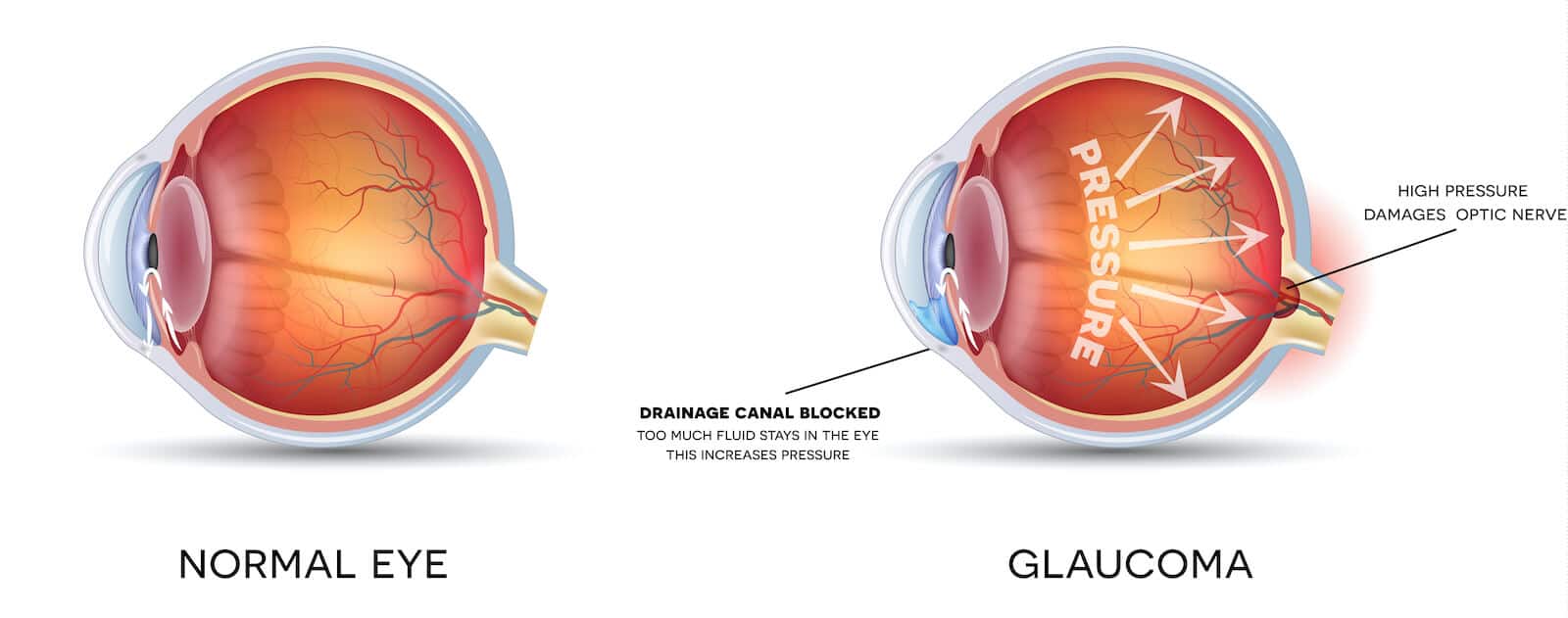Glaucoma
Have you recently found out you have glaucoma? Glaucoma is an eye condition that causes irreversible vision loss.
However, with proper management and treatment, the Eye Center of St. Augustine team can help you preserve your remaining vision for many years to come.
What is Glaucoma?
Glaucoma is an eye condition that causes permanent and irreversible damage to the optic nerve. The optic nerve sends messages to your brain and translates them into the images you see.

If the optic nerve suffers any damage, it affects your ability to see. When you have glaucoma, it’s usually due to increased fluid in the eye, leading to higher pressure in the eye.
When intraocular pressure gets too high, it damages the optic nerve, often leading to glaucoma.
Are There Different Kinds of Glaucoma?
Although there are several kinds of glaucoma, the two main kinds are primary open-angle glaucoma and angle-closure glaucoma. These two kinds are very different from each other.
Primary Open-Angle Glaucoma
The most common kind of glaucoma is primary open-angle glaucoma. With open-angle glaucoma, the condition occurs gradually because the eye cannot drain fluid properly.
Because there is too much fluid in the eye, pressure begins to build and damages the optic nerve. Open-angle glaucoma does not cause pain and often does not lead to any changes in vision at first.
Angle-Closure Glaucoma
With angle-closure glaucoma, it happens quite quickly instead of pressure building slowly. Angle-closure glaucoma occurs when the iris is exceptionally close to the eye’s drainage angle.
Being too close to this drainage angle can block it. If a blockage to the drainage angle occurs, pressure in the eye rises too quickly.
If the pressure rises very quickly, it can result in an acute attack, causing a medical emergency that requires immediate attention from your ophthalmologist. If left untreated, it will result in permanent vision loss or blindness.
Are There Symptoms or Warning Signs of Glaucoma?
Glaucoma is often called the silent thief of vision because it has few discernible symptoms or warning signs. Many patients don’t realize they have the eye condition until irreversible vision loss has occurred.
However, some symptoms of open-angle glaucoma become more apparent as the condition progresses. As it develops, the most common sign of open-angle glaucoma is noticing blind spots in your peripheral vision.
With angle-closure glaucoma, there are more symptoms. Early symptoms of the condition include:
It’s best to see your ophthalmologist if you begin experiencing any of these. These symptoms are not exclusive to angle-closure glaucoma and may indicate another eye condition.
How Do You Treat Glaucoma?

Although glaucoma may sound like a scary eye condition, it doesn’t have to be. You can manage its effects with proper treatment and prevent it from progressing further.
Your ophthalmologist at the Eye Center of St. Augustine may choose to treat glaucoma with various treatment methods. What they choose will depend on the kind of glaucoma, the severity of the condition, and how high your intraocular pressure is. At the Eye Center of St. Augustine, these include:
Eye Drops
Most eye doctors will begin glaucoma patients off on a regimen of eye drops to help lower and manage intraocular pressure. You must take these drops exactly as prescribed, which may be several times a day.
If these are ineffective or do not lower pressure enough, your ophthalmologist may recommend a surgical procedure to help manage your intraocular pressure.
Trabeculectomy
Trabeculectomy is a procedure to treat glaucoma where your surgeon will create a small flap in the sclera. The sclera is the white outer coating of your eye.
After creating the flap, they will make a bubble called a filtration bleb in the conjunctiva. You cannot see the bleb as it’s hidden under the eyelid.
Aqueous humor from the eye can drain through the flap and into the bleb. Once the fluid is in the bleb, it gets absorbed by the tissue around your eye, helping to lower intraocular pressure.
Selective Laser Trabeculoplasty
If you have open-angle glaucoma, your ophthalmologist may recommend a laser procedure called selective laser trabeculoplasty (SLT). SLT is a laser procedure that applies laser energy to the trabecular meshwork in the eye to help improve fluid drainage.
This improves how fluid drains through the trabecular meshwork and out through the eye. Eventually, it helps lower pressure in the eye, though it may take 1-3 months for full effects to become apparent.
What are MIGS?
MIGS refers to minimally invasive glaucoma surgeries. Traditional glaucoma procedures are more invasive and cause more trauma to tissues in the eye.
Because of this, the recovery time is longer with more traditional glaucoma procedures to lower intraocular pressure. MIGS procedures are not suitable for every patient.
Standard glaucoma procedures may be better if a patient has glaucoma that progresses past a certain point, hasn’t responded to eye drops, or wants a more long-lasting solution. Your eye surgeon can perform MIGS in combination with cataract surgery or by itself.
Kahook Dual Blade
At the Eye Center of St. Augustine, Dr. Nelligan offers a MIGS procedure called the Kahook Dual Blade. The Kahook Dual Blade is an outpatient procedure that uses a single-use ophthalmic blade to release intraocular pressure in glaucoma patients.
It achieves this by creating parallel incisions in the trabecular meshwork and the wall of Schlemm’s Canal. Using the Kahook Dual Blade ensures that natural outflow pathways in Schlemm’s Canal stay maintained to lower intraocular pressure in glaucoma patients.
Depending on your symptoms and initial intraocular pressure before the procedure, it may be performed during cataract surgery or as a standalone procedure.
Do you need more information about treatment options for glaucoma? Request an appointment at the Eye Center of St. Augustine in St. Augustine, FL, today!


